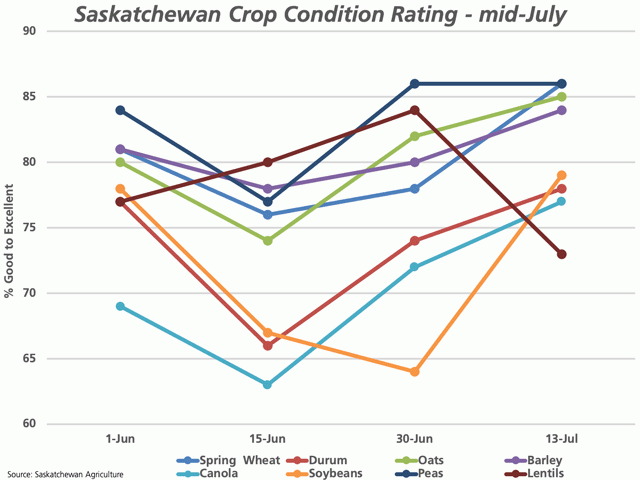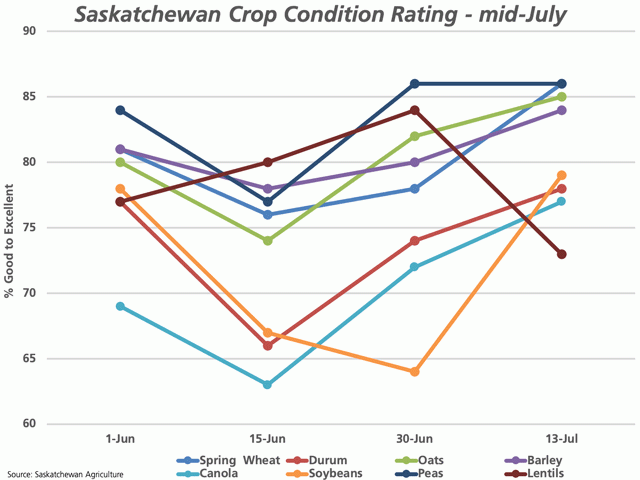Canada Markets
Saskatchewan Crop Condition the Highest in Four Years
The Saskatchewan government's weekly crop report, which includes a bi-weekly assessment of crop condition, shows crops at favourable growth stages, while the overall crop condition shows signs of improvement.
An estimated 75% of spring cereals are viewed as being at normal growth stages, which is second to the 77% reported in 2018, as seen in data for the past five years, while ahead of the five-year average of 67.2% for this week. An estimated 70% of the province's oilseed crops are estimated to be at normal stages, also the second-highest rating in the past five years, next to the 76% reported in 2018 and compares to the five-year average of 64%. The portion of the pulse crop at normal growth stages is seen at 82% of the crop, which is the highest rating seen over the past five years while compares to the five-year average of 71%.
Keeping in mind that the crop condition is reported every second week, starting at the beginning of June, the crop condition has shown signs of improvement in each of the past two reports to a 2020 high for spring wheat (86%), durum (78%), oats (85%), barley (84%) and canola (77%), with the July 13 Good-to-Excellent rating in brackets. The soybean rating reached a 2020 low of 64% as of June 30, while has recovered to a 2020 high of 79% Good-to-Excellent rating as of July 13. The dry pea rating has remained steady at 86% Good to Excellent over the past two reports, while the lentil rating reached a crop year high of 84% as of late-June, but has fallen to 73% by mid-July.
When this data is used to create a crop condition index (CCI), all crops are rated higher than their respective five-year average as of mid-July, ranging from 13.8% higher for oats to 45% higher for durum, while averaging 26% higher across these crops. The calculated CCI for these crops ranges from 184 for winter wheat, flax and canola to an index of 207 for peas.
P[L1] D[0x0] M[300x250] OOP[F] ADUNIT[] T[]
All of these calculated indices are the highest seen in the middle of July since 2016. Looking back at that year, the next and last crop condition for the season was released for July 25 that showed further rains leading to modest improvements in the crop condition for the cereal grains, flax and canola. At the same time, the G/E rating for soybeans tumbled 15 points over this two-week period from July 11 to July 25, while the pea condition fell by five points and the lentil condition fell by 17 points to 62% G/E as of late July. Excessive precipitation was reported as detrimental across the major lentil growing areas of the province.
While not all regions of the province have been looked at, it is interesting to note that the crop condition has shown modest improvement in the Northwest Region of the province, despite excessive rains over the past two weeks, with the spring wheat condition improving by 6 points to 92% G/E, while canola improved by 2 points to 86% G/E.
At the same times, rains over the past week have led to a huge improvement in the condition of the Southeast Region, viewed as the driest area of the province. The spring wheat condition improved by 24 points to 89% G/E over the past two weeks, while the canola rating improved by 19 points to 76% G/E.
One last observation comes from a comparison of the Saskatchewan government data and AAFC's Percent of Average Precipitation chart as of July 14. Despite the rapid improvement seen in crop condition in the southeast of the province, AAFC's chart shows most of southern and eastern Saskatchewan having received 60-85% of normal precipitation since April 1, with smaller areas having received 40 to 60% of normal precipitation. This area could remain vulnerable without ongoing precipitation, especially if hot summer temperatures are yet to come.
**
DTN 360 Poll
This week's poll asks how you view the rainfall that has hit your region to-date. Is it enough? Too much? You can weigh in with your thoughts on this week's poll, found on the lower-right side of your DTN Canada Home Page. We thank you for sharing your view!
Cliff Jamieson can be reached at cliff.jamieson@dtn.com
Follow him on Twitter @Cliff Jamieson
© (c) Copyright 2020 DTN, LLC. All rights reserved.






Comments
To comment, please Log In or Join our Community .